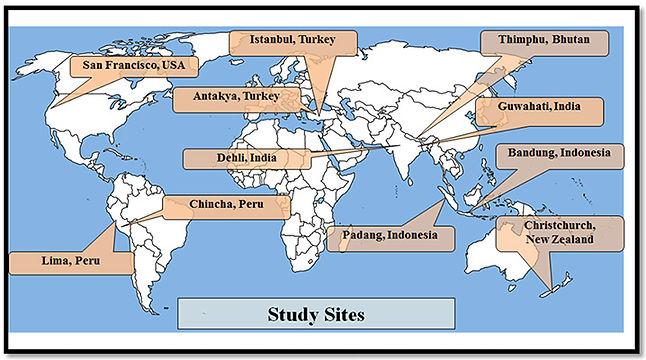Location
Date
Date
Date
Date
Date
Date
Location
Date
Date
Date
Date
Date
Date
Newsletter
Global Earthquake Model (GEM) Beneficiary Needs
A study of earthquake risk reduction activities, needs, and barriers, to help guide GEM’s future tool and resource development for users who are not risk assessment experts.

GHI’s Justin Moresco with Carla Johnson, one of the community leaders interviewed for the project and a staff member of the San Francisco Mayor’s Office on Disability. The two review a map that shows the intersection of vulnerable people, vulnerable buildings and vulnerable sites within San Francisco.
The Problem
More than half a million people died in the last decade due to earthquakes, with most of these deaths occurring in developing countries. While there is no single solution to avoiding catastrophic losses in the future, one glaring problem is the lack of reliable earthquake risk information in many regions of the world.¹ Even when risk models do exist, they are often inaccessible due to their proprietary nature or complex user-interfaces. Yet, providing risk information to people in seismically active areas is critical for community leaders to make smart decisions about the policies and practices they should pursue to build communities that are safer and more resilient from earthquakes.
The Pavia, Italy-based Global Earthquake Model (GEM) is an initiative to calculate earthquake risk worldwide and to make this information available to anyone with an Internet connection through an open, web-based platform. GEM, which is funded by national governments, private corporations and foundations, wants to develop software tools that help increase earthquake risk awareness and that promote mitigating activities, such as retrofitting programs or the adoption of seismic building codes.

Global Earthquake Model project sites.
GHI’s Response
GeoHazards International (GHI), in partnership with the Center for Disaster and Risk Analysis at Colorado State University, conducted an 18-month study to investigate the needs of selected GEM beneficiaries and to describe how GEM could most effectively communicate its earthquake risk information to promote mitigating action. To achieve these goals, the project team traveled to 11 cities in seven countries (Bhutan, India, Indonesia, New Zealand, Peru, Turkey, and the United States) to interview more than 130 government officials, school and hospital administrators, and business and nonprofit leaders working on earthquake safety in their communities.
The project team analyzed the responses from these interviews and organized the findings into three categories: existing earthquake risk reduction programs and activities; earthquake risk reduction resource needs; and barriers to implementing risk reduction activities. The project team then drafted a series of recommendations, which were meant to turn the findings into actionable steps that GEM could take to support earthquake practitioners in seismically prone communities around the world.
Documents:
